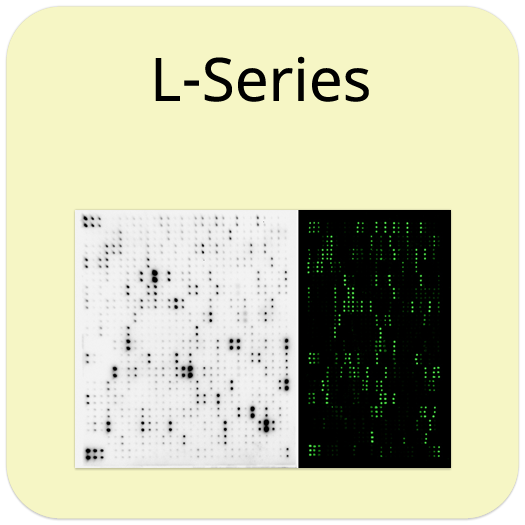Product Features
- High density arrays
- Unbiased detection through direct biotin labeling of samples
- Low sample consumption
- High detection sensitivity
- Same day result
- Affordable and simple to use
Target Names
A4GALT, ABCB9, ABCC2, ABCC3, ABCD1, ABHD14B, Abl interactor 2, ABLIM1, ACADL, ACIN1, ACOT13, ACOT2, ACOX1, ACSBG1, ACSL1, ACSL5, ACSS3, ACYP2, ADCYAP1R1, ADK, ADSL, AIM2, AKR1A1, AKR1B10, Aladin, ALOX15B, ALOX5AP, AMFR, ANAPC13, Anoctamin-1, AP1B1, Aquaporin-1, Aquaporin-9, ARD1A, ARF3, ARID1A, ARID1B, ARL2BP, Aromatase, ASB2, ASF1A, ATIC, ATL3, ATOX1, ATP1B1, ATP6V0A2, ATP6V1F, ATPIF1, AZI2, B3GAT3, B3GNT3, BABAM2, BCL2L1, BCL2L12, BCL6, BDKRB1, BET1-like protein, BHLHE40, BLNK, BMF, BOLA1, BPHL, BTN3A3, BVES, CA7, Calmodulin-2, Calsequestrin-2, CAMK1, CAMK4, CAPZA2, CAPZB, Caspase-5, Caspase-6, Cathepsin K, CBFB, CBLC, CBR3, CD247, CD3E, CD81, CD8B, CDC37, CDC42, CDC42BPB, CDC6, CDCA3, CDH16, CDK6, CDS2, CEBPB, CGREF1, CHMP4A, CHN1, CHRNA7, CKMT1A, Claudin-7, CLCA1, CLPB, CMBL, CNOT6, CNPY2, COASY, COL6A3, COMMD8, CPLX3, CPSF6, CPT2, CPVL, CRABP1, CRABP2, CRADD, CRELD1, CRYZ, CSNK1G2, CSNK2A2, CST7, CUTC, DAO, DCLK1, DCUN1D1, DDX41, DHRS2, DHRS4, DHRS9, DHX15, DIS3L, DNA helicase MCM8, DNA ligase 1, DNAJC30, DNASE2, DNTT, DPF3, DPYSL5, DUSP14, Dynamin-1, DZIP1, E2F5, EBPL, ECD, ECH1, ECSIT, EEF1B2, EFNA1, EHD2, EIF1AY, EIF3D, EIF3G, EIF3J, EIF3K, EIF4EBP1, EIF5A2, Elastin, EMR1, Epsin-3, ERCC5, EWSR1, EXOSC10, F8, FAR2, FAU, FBL, FBXO6, FGFBP3, FHIT, FSTL5, GABARAPL2, GADD45G, Galactokinase, GALE, GALNS, GBP2, GCDH, GCM2, GFER, GGA1, GGA3, GLIPR1, GLT8D2, GMEB1, GMFG, GNG13, GNGT1, GOPC, GPD2, GPR37, GRIK2, GSTK1, GSTM5, GSTZ1, GUCA1A, HAT1, HDAC1, HDAC3, HDAC6, HERC2, HERPUD1, HIST1H2BB, HIST1H3A, HIST2H2BE, HNF1A, HNMT, HRAS, HSD3B1, HSPA6, HTR3B, HTRA3, IDI2, IDO2, IFITM2, IFN alpha 5, IFNA2, IFNW1, IGJ, IGSF8 (CD316), IMP3 , IMPA1, INSL5, Integrin alpha-E, Interferon alpha-10, Interferon alpha-8, Isthmin-1, ITCH, KCNJ12, KCNQ5, KIAA0101, KIAA1279, KLF13, KLF7, KLRC1, KRT24, KRT7, KRT78, KRT79, LAPTM4A, LIN52, LRIG1, LRP10, LRP11, LSM3, LSM7, LSP1, LTC4S, MAG, MAGOH, Major vault protein, MAN1A2, MAP4K3, MAPK1, MAPK8, MAPKAPK3, MAPRE3, MASP2, MAX, MCTS1, MECP2, MRPL11, MRPL12, MRPL15, MRPL30, MRPL44, MRPS2, MRPS5, MRTO4, MS4A1, MUS81, NAALADL1, Nanos homolog 1, NARS, NCKAP1, NDRG1, Netrin receptor UNC5A, NFE2L3, NGLY1, NMRAL1, NOS1AP, NPC1, NSFL1C, NTNG1, NTS, Nuclear pore glycoprotein p62 (Nucleoporin Nup62), Nucleolin, NUDC, NUDT1, NUP107, NUP50, OLFM4, OTX1, OXCT1, P2X purinoceptor 5, P2Y purinoceptor 6, PABPC3, PADI4, PAPOLA, PARD6B, PARVA, PCF11, PDCD10, PDCD6IP, PDE1C, PDE9A, PDK1, PDRG1, Pepsin A-4, PEX13, PEX19, PEX3, PFDN5, PFKFB4, PFKP, PFN2, PGS1, PHF1, PHF13, PIAS1, PIGK, PIK3CA, PIM1, PIPOX, PLBD2, PLK4, PLN, PLSCR3, PMCH, PML, PMM2, PNPT1, POLR3B, POP4, PPIE, PPIF, PPIP5K2, PPP1CC, PPP1R17, PPP2R5E, PPT1, PQBP1, PRAC1, PRDM2, PRICKLE2, PRKAR1A, PRKD2, PRKG2, PRMT5, PRMT6, Proenkephalin-B, Prohibitin-2, Protein BTG3, Protein FAM98A, Protein KIBRA, Protein MTSS 1, Protein orai-3, Protein OS-9, PRPF18, PRPF19, PSME1, PSME2, PSME3, PSMF1, PTGES, PTPN12, PXMP4, RAB11B, RAB27B, RAB31, RAB6A, RAB8B, RAD54B, RAET1L, RBKS, RBL2, RBM34, RBP5, RBP7, RELA, REXO1, RFK, RHOT1, Ribonuclease H1, RING1, RIOK2, RNASEH2B, RNF41, RNMT, RPL36, RPP14, RPRD1B, RRAGC, RUVBL1, RXFP3, SACM1L, SCARB1, SCLY, SCN2B, SCPEP1, SDF2, SDHB, SEC11C, SEC23B, SECTM1, SELM, SETD8, SF3B4, SHOC2, SIPA1, SIRT4, SLC19A3, SLC22A7, SLC22A8, SLC26A6, SLC27A4, SLC2A10, SLC34A1, SLC34A3, SLC39A8, SLC6A1, SLC9A3R1, SLK, SMG1, SMN1, SMPD2, SMYD2, SNRPD2, Sorting nexin-2, SP1, Sp-100, SP4, SPCS2, Speedy protein C, SPEG, Splicing factor 45, SRP72, SRSF10, SSR1, ST7, STAG1, STC-2, STK16, Syntaxin-8, SYT6, TAZ (WWTR1), TBCB, TBP, TFDP1, TJP1, TJP2, TLE3, TLK1, TP53I3, TPPP3, TPT1, TRH, tRNA, TSG101, TSPAN1, TST, TTF1, TTF2, TUBG1, TXNL4A, TXNRD1, TYMS, TYRP1, UBASH3A, UBE2F, UBE2H, UBE2I, UBE2M, UBE2T, UBE2W, UBE3A, Ubiquilin-2, UBXN6, UGDH, UGP2, UNC13C, UNG, uPA, UPF3B, UROS, USP30, USP46, UTP18, UXS1, VARS, VKORC1, VLDLR, VNN2, VPS25, VPS26A, VRK1, VSNL1, VTA1, VTI1A, VTI1B, WDR61, XCL2, XPC, XRCC1, XRCC2, ZFP36L2
Application Notes
Suggested Application
Multiplexed Protein Detection; Detection of Relative Protein Expression; Detecting Patterns of Cytokine Expression; Biomarker Screening; Identifying Key Factors; Confirming a Biological Process; Cross-species testing
Kit Components
- RayBio® L-Series Antibody Array Glass Slide(s)
- Spin Columns
- Labeling Reagent
- Stop Solution
- Blocking Buffer
- Wash Buffer 1
- Wash Buffer 2
- Streptavidin-Conjugated Fluor
- Adhesive Plastic Strips
- Labeling Buffer
- Lysis Buffer
- 30 ml Centrifuge Tube
Other Materials Required
- Distilled or de-ionized water
- Small plastic or glass containers
- Orbital shaker or oscillating rocker
- 1 ml tube
- Pipettors, pipette tips and other common lab consumables
- Aluminum foil
- Gene microarray scanner or similar laser fluorescence scanner
View Compatible Laser Scanners
Don't have a compatible scanner? RayBiotech now offers FREE scanning service for all RayBio glass slide antibody arrays! Learn More
Protocol Outline
- Purify Samples with Spin Column
- Biotinylate Samples
- Purify biotinylated samples using spin column
- Dry the glass slide
- Block array surface
- Incubate with Samples
- Incubate with Streptavidin-Conjugated Fluor
- Disassemble the glass slide
- Scan with a gene microarray laser scanner
- Perform densitometry and analysis
Storage/Stability
For best results, store the entire kit frozen at -20°C upon arrival. Stored frozen, the kit will be stable for at least 6 months which is the duration of the product warranty period. Once thawed, store array slide(s) at -20°C and all other reagents undiluted at 4°C for no more than 3 months.


